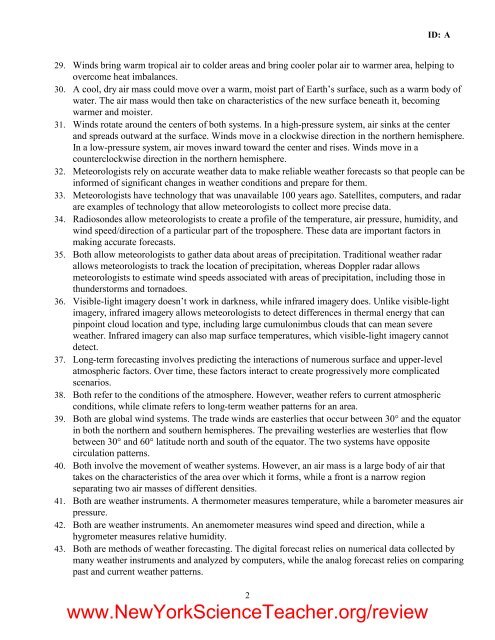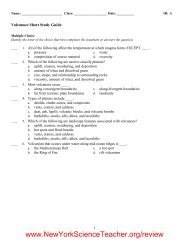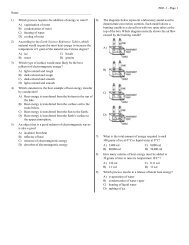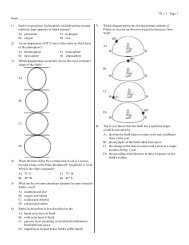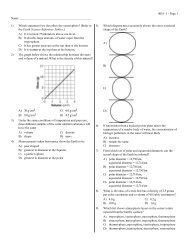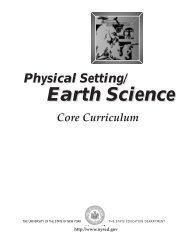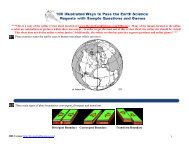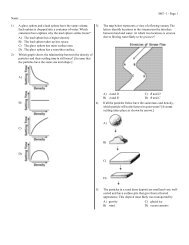Meteorology Study Guide - Earth Science Regents Review
Meteorology Study Guide - Earth Science Regents Review
Meteorology Study Guide - Earth Science Regents Review
You also want an ePaper? Increase the reach of your titles
YUMPU automatically turns print PDFs into web optimized ePapers that Google loves.
ID: A29. Winds bring warm tropical air to colder areas and bring cooler polar air to warmer area, helping toovercome heat imbalances.30. A cool, dry air mass could move over a warm, moist part of <strong>Earth</strong>’s surface, such as a warm body ofwater. The air mass would then take on characteristics of the new surface beneath it, becomingwarmer and moister.31. Winds rotate around the centers of both systems. In a high-pressure system, air sinks at the centerand spreads outward at the surface. Winds move in a clockwise direction in the northern hemisphere.In a low-pressure system, air moves inward toward the center and rises. Winds move in acounterclockwise direction in the northern hemisphere.32. Meteorologists rely on accurate weather data to make reliable weather forecasts so that people can beinformed of significant changes in weather conditions and prepare for them.33. Meteorologists have technology that was unavailable 100 years ago. Satellites, computers, and radarare examples of technology that allow meteorologists to collect more precise data.34. Radiosondes allow meteorologists to create a profile of the temperature, air pressure, humidity, andwind speed/direction of a particular part of the troposphere. These data are important factors inmaking accurate forecasts.35. Both allow meteorologists to gather data about areas of precipitation. Traditional weather radarallows meteorologists to track the location of precipitation, whereas Doppler radar allowsmeteorologists to estimate wind speeds associated with areas of precipitation, including those inthunderstorms and tornadoes.36. Visible-light imagery doesn’t work in darkness, while infrared imagery does. Unlike visible-lightimagery, infrared imagery allows meteorologists to detect differences in thermal energy that canpinpoint cloud location and type, including large cumulonimbus clouds that can mean severeweather. Infrared imagery can also map surface temperatures, which visible-light imagery cannotdetect.37. Long-term forecasting involves predicting the interactions of numerous surface and upper-levelatmospheric factors. Over time, these factors interact to create progressively more complicatedscenarios.38. Both refer to the conditions of the atmosphere. However, weather refers to current atmosphericconditions, while climate refers to long-term weather patterns for an area.39. Both are global wind systems. The trade winds are easterlies that occur between 30° and the equatorin both the northern and southern hemispheres. The prevailing westerlies are westerlies that flowbetween 30° and 60° latitude north and south of the equator. The two systems have oppositecirculation patterns.40. Both involve the movement of weather systems. However, an air mass is a large body of air thattakes on the characteristics of the area over which it forms, while a front is a narrow regionseparating two air masses of different densities.41. Both are weather instruments. A thermometer measures temperature, while a barometer measures airpressure.42. Both are weather instruments. An anemometer measures wind speed and direction, while ahygrometer measures relative humidity.43. Both are methods of weather forecasting. The digital forecast relies on numerical data collected bymany weather instruments and analyzed by computers, while the analog forecast relies on comparingpast and current weather patterns.2www.NewYork<strong>Science</strong>Teacher.org/review


